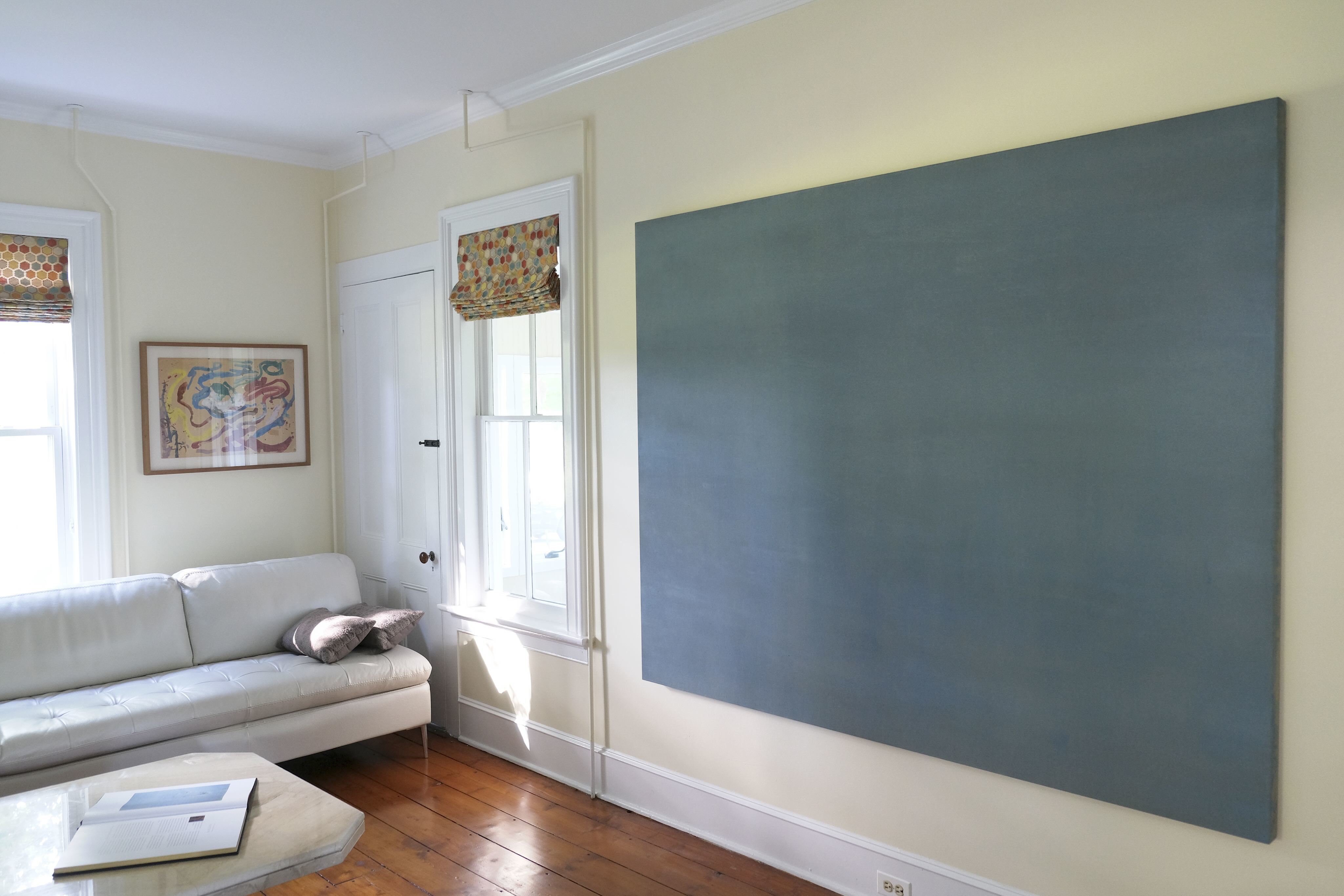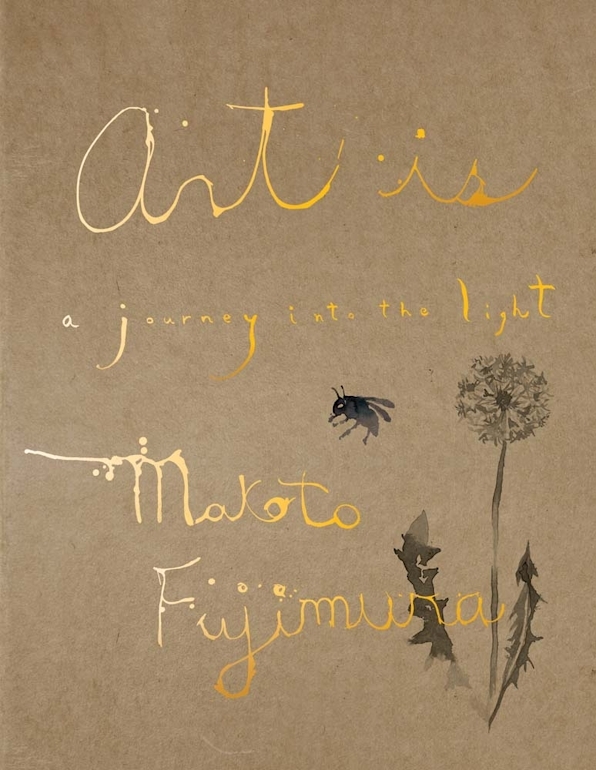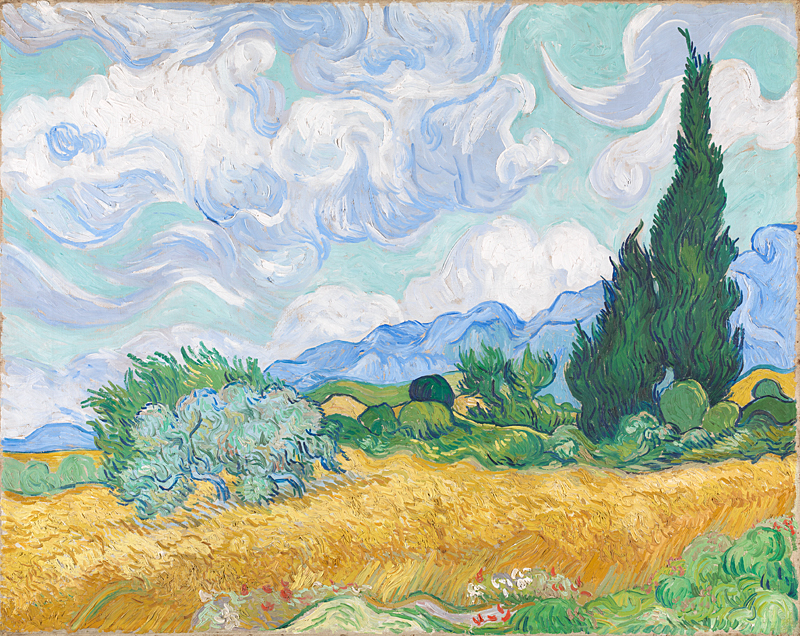“Art is not found in flashy fame or selfish ambition measured in human clocks. Instead, we must realize — and honor — that there are particular seasons. It is the gentle cultivation of spaces and community where beauty can flourish. It is the willingness to wait, to be attentive, to tend.”
– Makoto Fujimura
Heading image: Vincent van Gogh (1853−1890), A Wheatfield, with Cypresses, 1889, oil on canvas, 72.1 x 90.9 cm. The National Gallery, Public Domain.
A Note from IAMCultureCare
Greetings this sultry (for most of our readers) July!
This is a glorious month for growing things. The sun is welcomed by busy bees and the plants they pollinate, while photosynthesis — that mystical process of light (both a particle and a wave) converted into life-giving food — supports ripening fruit. This is peak blueberry season.
Less glorious is the sun’s heat. I’ve just returned to New Jersey after spending a week in the UK’s recent heatwave, which I blithely went into expecting to feel a smug superiority, a mere 80 degrees Fahrenheit nothing to my American midwestern self. Oh, how my air-con-craving heart was humbled!
Summer, though, is a time not only of sun but also of storms. Our hearts are heavy for the victims and their families impacted by the flooding in Texas. Losses like these impact and implicate us all, whether we are closely connected or not. For those of us though who have spent time in Kerr county, walking along the Guadalupe River or hiking in the beautiful Texas hill country around San Antonio, this latest tragedy in a litany of recent global, “unprecedented” flooding tragedies is devastating.
Such flooding brings with it a sharply obvious paradox: destructive and purifying, the water leaves in its wake both loss and a clean slate as all that is impermanent — including, painfully, human life itself — is swept away. What can we offer in response to such a reality?
The response and responsibility of artists, of culture care, is always to make something new from the fragments. In the midst — in spite, in defiance — of deep loss, new creation is the only possible alternative to despair. Such acts of making do not seek to whitewash or sentimentalize suffering, but they recognize with Simone Weil that beauty and affliction are the dual entry points to experiencing the true gravity of all things.
The question for us is, rather than politicizing or polemicizing, do we have the patience and willingness to bear that weight?
As Mako implicitly urges below, this is the generational work of Culture Care, Such work matters for a growing and hurting world.
Jacob Beaird, Editor
A Note from Mako Fujimura
In the Time of Blueberries
This is the time of blueberries.
On the recent July 4th weekend, we invited the children of friends to help me pick the blueberries producing in abundance at Fuji Farm. On that bright, crisp morning — before the summer sun could weigh into our day — I unwrapped the cover protecting the fruit from birds and we began our harvest. The berries were fat with ripeness, dusky blue and full of tartness. The children’s hands, low to the ground, small and quick, reached through the branches easily in ways that convinced me that this was the perfect activity for them.
Catbirds watched from nearby, flickering through the bushes. They know the timing better than we do. They wait for what we miss, trusting our imperfection to give them their share.
There is something liturgical about harvesting together in this shared act every July that reorients us. It invites us to move not by the clock, but by ripeness. To follow not speed, but the seasons. To identify fruitfulness is part of our design.
Blueberries ripen rather slowly, and can surprise you with their abundance on a small, but full, bush. When it is ready, the steward must harvest them right away. If you miss the timing, the fruit will fall to the ground. But if that timing is right and you have children ready to help, a child gets to taste what abundance truly means. They are amazed how different the taste is compared to the berries from supermarket shelves. Even just two small bushes produces enough blueberry feast for all of us. Enough even for the catbirds to swoop in to get the ones over-ripened or dropped to the ground.
Culture Care is like this.
Art is not found in flashy fame or selfish ambition measured in human clocks. Instead, we must realize — and honor — that there are particular seasons. It is the gentle cultivation of spaces and community where beauty can flourish. It is the willingness to wait, to be attentive, to tend. It is children’s laughter among the branches on bent knees. It is stained fingers and shared buckets. It is believing that goodness can still be grown — slowly, lovingly — right in front of us.
***

Blueberry in the Fuji Farm “Listening Room”. Photograph by Makoto Fujimura.
My painting Blueberry is hung in our “Listening Room” in the farm house. It is a large painting in a series of paintings I started during the Pandemic shutdown, and it is highlighted in my next book Art Is: A Journey into the Light. The painting is composed of 200 layers of one type of pigment: a unique azurite that is an absolutely “silent” paint. My wife, Haejin, created this room to be able to fully “see” the painting by sitting quietly in front of it.
After picking the abundant blueberries, tartness and sweetness still in their mouths, the children sat in front of the painting, pondering what they saw. This monochromatic painting has confounded many (adults) who encounter it on my social media feeds (especially on @fujimuralisteningroom). They ask, “What does it mean?” or even, mockingly, “What is it?” The polite ones ask, “Can you explain this painting to me?”
But these children had no trouble using their imagination to see beneath and beyond the surface. They were even teaching each other to see. If you quiet your heart, you can begin to perceive the prismatic light shimmering across over 200 layers. One of these Blueberry paintings will be exhibited at Gordon College’s Barrington Center for the Arts this fall in a “Listening Room” we will be creating. Certainly these children are well prepared by my friend/their father to be comfortable and engaged, beholding any art work. They have been raised to be attentive to what they see, to be aware, and have learned to articulate what they see.
Culture Care is a generational work.
We live in a time when everything around us urges acceleration and angry, exasperated responses: faster information, faster production, even faster forgetting. But the flavor of a blueberry refuses such terms. It ripens in secret under watchful skies and in soil we did not make but only amended. The bursting, complex taste will remain in our memories. The Blueberry painting — also simple but complex — can invite the curiosity of a child.
And we are invited, not to control it, but to receive.
The blueberries have ripened now.
The Blueberry painting’s layers continue to settle, even after two years.
May we be the ones who rise early.
May we walk slowly, with children, and pick what grace has made ready.
May we leave some for the catbirds.
And may we remember that abundance is not a miracle of our making, but a mystery we are blessed to witness.
***
Culture Care Group Conversation Starters
- What does “ripening” look like in your life right now?
Where are you being asked to wait, to tend, or to harvest gently — not with haste, but with attention? - What spaces in your life or community feel like ‘shared buckets’ — places of gentle cultivation, imagination, or childlike wonder?
How can you protect and nurture these spaces? - What does it mean to “leave some for the catbirds”?
In your vocation, relationships, or creative life, how might you practice this kind of generous imperfection — trusting that not all fruit must be gathered, that beauty also belongs to others, even to the unseen?
Culture Care Events & Announcements
- Art+Faith: A Theology of Making Author Event—Utrecht, Netherlands, July 17. For our readers in or around Utrecht, join Mako Fujimura for an author talk / meet & greet NEXT WEEK hosted by the Theological University Utrecht. The event celebrates the recent translation of Mako’s book Art+Faith into Dutch (Kunst+geloof: een theologie van creatie), and copies of the Dutch translation will be available for purchase at the event. RSVP for free admission at the link above.
- Spirit & Scribe: Writing Workshop—Virtual, Wednesday evenings in August. IAMCC community-member and poet Michael Stalcup leads a four-week workshop on the intersection of writing and spiritual formation.
- PAX Fellowship—Applications open through July 15. Also shared by Michael Stalcup, PAX is a nine-month fellowship for emerging artists and Christians of color. The experience includes teaching, group mentorship, spiritual direction, contemplative practices, and community building for peace and justice.
- “Into the Silence: Winter into Spring” Exhibition—Boston, MA, August 27-October 15. Mako Fujimura and Bruce Herman to exhibit original works from the QU4RTETS project alongside newer works by Fujimura in a special exhibit in Gordon College’s Barrington Center for the Arts. Additional details and events TBA.
- Makoto Fujimura: Art Is: A Journey Into the Light is published October 21. Mako’s next book with Yale University Press will be available this fall wherever books are sold (pre-order now from any of the retailers linked here!). Art Is takes readers along on Mako’s meandering journey as an artist. We witness him making his“process-driven slow art” — using pulverized minerals, gold, or pigments made from oyster shell — as he considers the plants and wildlife on the land where he lives, including further reflections on tree swallows! Bringing together the author’s written reflections with over 70 of his paintings, drawings, and photographs in full color, Art Is invites us to see the world in prismatic and diverse lights, helping us navigate the fractured, divisive times we live in.
Do you have a news item or upcoming culture care event? Consider sharing it with us for a possible feature here in the newsletter! Email jacob@internationalartsmovement.org.

Web Links
- Latest Belonging Conversation from Mako Fujimura and Julia Hendrickson.
- Mako and Haejin Fujimura “Still Life with the Fruit of the Spirit” in Christianity Today.
- Jessie Epstein for Inkwell on human error and AI.
- New music recs: Lisa Knapp and Gerry Diver’s collaborative contemporary folk “Hinterland”; The Westerlies’ album “Paradise”, blending the shape-note music of the Sacred Harp with jazz and contemporary chamber music in their distinctive brass arrangements; choral group VOCES8 celebrates their 20th anniversary.
- If you like the VOCES8 album, the Gramophone Podcast reports on it and the group’s generative history.
- The Public Domain Review highlights a 1929 short story about heatwaves.
- The Rabbit Room’s podcast Hutchmoot on Hayao Miyazaki and beauty.
- David Zahl for Plough on the wellness industry and despair.
- Gustav Mahler was born 165 years ago this week; here’s an irreverent but fun take on his fifth symphony.
IAMCultureCare is a registered 501c(3) non-profit organization that relies on your support to continue our Culture Care efforts of amending the soil of culture as an antidote to toxic culture wars. This newsletter and our other programming do that effectively, and we welcome gifts of any size to continue these efforts. You can donate online or get in touch with us about corporate sponsorship and other giving methods!
All content in this newsletter belongs to the respective creators, as noted, and is used with permission. If you would like to submit something for consideration in a future newsletter issue, you may do so by filling out this form or by emailing jacob@internationalartsmovement.org.
